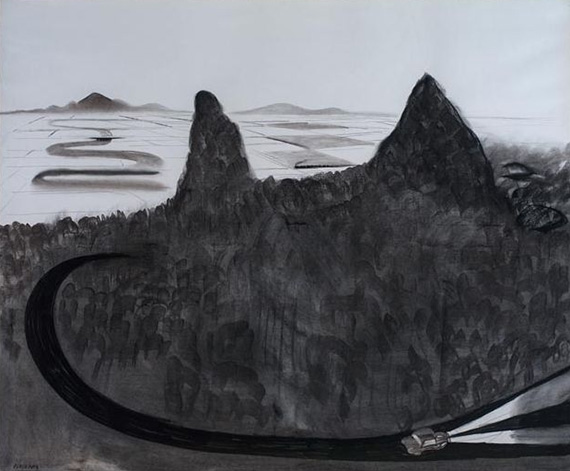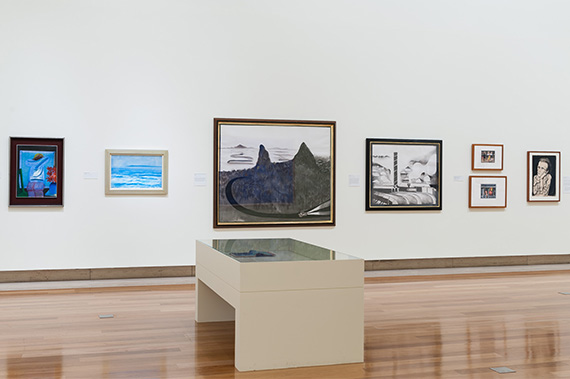
The preparation of artworks by Gallery Conservators for the exhibition ‘Lure of the Sun: Charles Blackman in Queensland‘ offered an opportunity to observe Blackman’s deliberate selection of certain materials and techniques to depict his subjects.
This exhibition explores Blackman’s formative relationships with Queensland artists and writers that were pivotal in his development as one of Australia’s most prolific and profound artists. Here we discuss two charcoal drawings featured in ‘Lure of the Sun’.
Although primarily known as a painter, it was his charcoal drawings which were fundamental in his initial recognition within the Melbourne art scene. In 1986, when gifting George Johnston c.1964 into the Gallery’s Collection, Pamela Bell said
I consider it to be a drawing of Charles at his best, it is a drawing of the greatest command of technique and insight into George
And indeed this drawing is a compelling portrait with a range of exquisite techniques. The sitter is framed by a dense sumptuous velvet background created by the application of willow charcoal.

Blackman used the sides of the willow stick to create an undulating ripple of the fabric and few lines to form the soft folds in the shirt. Willow charcoal is made from natural willow which is cooked in a low oxygen environment so it doesn’t disintegrate into ash. Willow charcoal is very soft to use and broad sticks are fantastic for fast coverage of large areas. Although it can be easily removed, it does not adhere particularly well to the paper surface, so it is very vulnerable to smudging. The background in this drawing is unfixed and has fortunately retained its luscious and tactile surface. In preparation for ‘Lure of the Sun’ we reframed this work with museum grade low static laminated glazing to preserve its beautiful surface.
The fine loose vine charcoal lines of his wistful eyes capture a sombre contemplative mood. Vine charcoal is also natural charcoal however it is harder than willow charcoal and harder to erase. It makes a fairly grey black, which can be seen in the paler wrinkled lines surrounding George’s face.


The drawing of George Johnston is on architectural detail paper. There is an overall discoloration, which is due the inherit nature of paper made from ligneous wood pulp which degrades with age. The characteristic serrated edge of the detail paper torn from the roll is only visible when you lift the window mount and there is a small tear in the lower left hand corner formed during Blackman’s energetic drawing of the sitter, and shows just how thin and light weight the detail paper really is.

Round the mountain and across the field c.1978 is an impressive drawing due to its ambitious size. Blackman used a single large sheet of light weight card. Given its size it has been necessary to roll the work in order to transport it and as a result the image has sustained handling creases throughout where it has been flatten prior to being framed. The soft willow charcoal has been utilised here to create a claustrophobic environment. The small car in the lower right corner is dwarfed by the surrounding landscape and towering mountain range. The car’s head lights struggle in a perilous winding journey as the forest encloses in from all sides.

Appreciate the brilliance of Charles Blackman and view these drawings for yourself. ‘Lure of the Sun: Charles Blackman in Queensland’ is at the Queensland Art Gallery until 31 January 2016 and is accompanied by a richly illustrated monograph featuring three essays exploring Blackman’s years in Queensland, focusing on the artist’s creative friendships with painters and poets, his connection with the young artists of the Brisbane-based Miya Studio and Barjai writers, and revealing the findings of recent conservation research into the artist’s materials and techniques.
Author George Johnston is best known for his semi-autobiographical novel My Brother Jack, published in 1964, which won the Miles Franklin Award that same year.
In 1986, Queensland poet Pamela Bell gifted to the Gallery Jon Molvig’s 1957 portrait of Blackman, and then, the following year, Blackman’s drawing of Johnston. These gifts recognised the contribution of Brisbane commercial gallerists Marjorie and Brian Johnstone to contemporary Australian art in Brisbane, and to Blackman’s career.
Bell wrote of Blackman’s work:
… It represents for me a time of mutual friendship between us all . . . and commemorates a memorable lunch, the Blackmans, Judith Wright, George and I, so again it is in the tradition of the works I am in the process of gifting to the Gallery, which in differing ways are about friendships and eras in the cultural life of Queensland.
Subscribe to YouTube to watch behind-the-scenes footage and exclusive interviews / Read more on our blog
Samantha Shellard is Conservator, Works on Paper, QAGOMA

